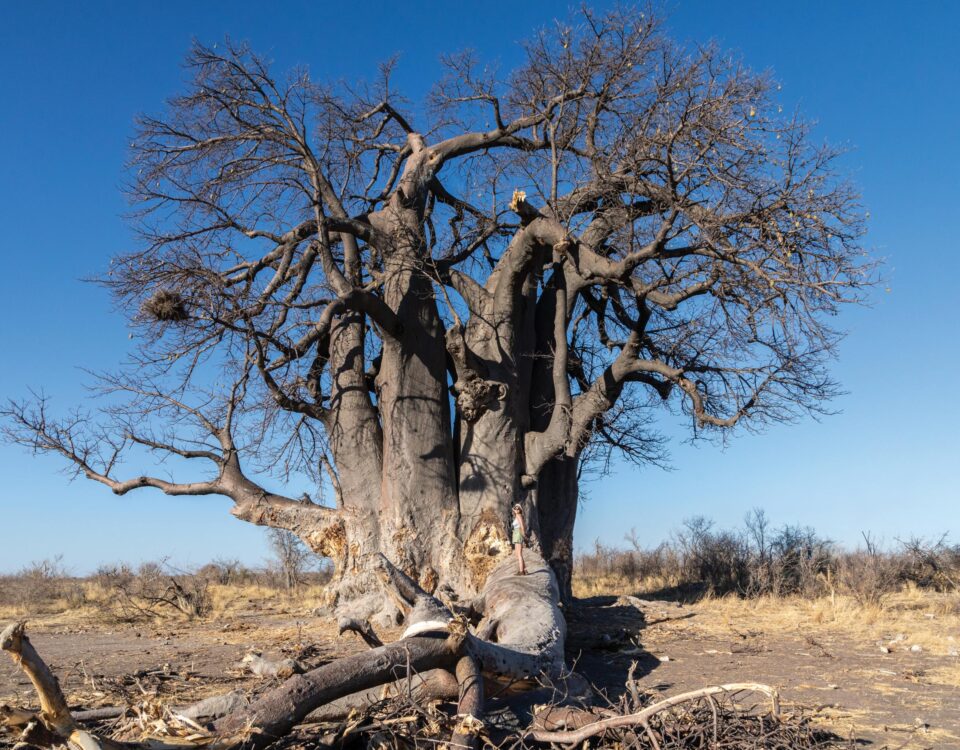Dynamite in a small package – Patricia Skyer
July 6, 2012Save the Rhino Trust: Their passion lives on
July 6, 2012By Michaela Kanzler
Wings folded behind his back, the big bird strides towards the carcasses. As soon as he starts to tear at the flesh with his curved bill, others flock closer from where they are huddled on the ground and in the trees in their dozens, even hundreds. The barbed wire does not seem to deter them. Several pairs of eyes eagerly watch their movements. And then the trap snaps shut: as if by magic a curtain closes over the open side of the large cage. Caught!
But no harm will come to the vultures. Their captors have no intention of killing them. Quite the opposite: they want to protect them. After weighing, measuring and ringing the birds, they will be released again. The Rare and Endangered Species Trust (REST), helped by volunteers from Raleigh International, has set up a ‘vulture restaurant’ and a special aviary for watching and catching the birds at Farm Uitsig, about 50 km north east of Otjiwarongo, within sight of Waterberg.
Established in September 2000 by Maria Diekmann, the aim of the REST Foundation is to study and protect Namibia’s endangered avian species. A chief concern is the Cape griffin vulture (Gyps coprotheres), which occurs only in Southern Africa and is endangered in Namibia. The country’s last colony of eleven Cape griffins is based on the cliffs of Waterberg. Only 50 years ago there were about 500 of these birds here.
In Namibia the main threat to vultures is poison put down by farmers to kill problem predators. Since vultures always feed in large numbers, it often happens that between 50 and up to 500 birds are affected. Furthermore, their habitat is shrinking. One reason is bush encroachment, leaving insufficient space for the vultures to become airborne. However, vultures play an important role in Namibia’s overall ecosystem. They are immune to anthrax and by feeding on carrion, they curb the spreading of the bacillus.
REST set up a restaurant and screen near the farmhouse at Uitsig in 2002. The ‘menu’, mostly offal unsuited for human consumption, is provided by Westland Meat in Otjiwarongo.
Next to the restaurant the Diekmanns put up the Nedbank Capture Aviary, named in honour of the sponsor. One part of the large enclosure houses 17 rehabilitated Cape griffins from the De Wildt Cheetah Research Centre in South Africa. After a settling-in period they will be released in November to reinforce local numbers. The other part of the aviary is used for catching vultures. Since the enclosure can be closed by a ‘curtain’, birds are not injured. Indications are that very little stress is caused.
The trapping device is highly effective. Nowhere else in the world were so many vultures captured within such a short period of time: almost 800 in 2004, of which 600 were ringed. This enormous number refutes the criticism of some scientists that vulture restaurants are ‘feeding places’ to which the birds would keep returning, thereby adapting an unnatural pattern of behaviour. Only about 20 of the more than 600 ringed vultures come to the weekly feeding time at the REST restaurant. Some of the older birds are among the ‘regulars’ who come once a month, while younger ones turn up only three times a year. Is this developing into a habit? Not at all, considering a vulture eats about 4 kg of carrion every three to four days.
Where, then, are the vultures for most of the year? More particularly, where are the Cape griffins? What are their routes, and how fast do they fly? Where are their nests, and do they have chicks?
In order to find out, the vultures’ movements have to be monitored by satellite telemetry. The cost of the state-of-the-art equipment and satellite signals for two years amounts to US$11 000 (about N$70 000) per bird. Diekmann found sponsors for five transmitters. Once again the trap at the aviary proved its worth. The first Cape griffin was caught in January 2004 and fitted with a type of backpack containing the transmitter. Nedbank, sponsoring the equipment and tracking costs, named its bird Sky Banker. In March Ned and Diana Twining (of the world-famous tea company) became the sponsors of Teabag.
The scientists receive five to eight daily satellite readings per bird, enabling them to determine what the vulture is doing at a specific time, where it is, whether and for how long it is foraging, and whether it is breeding. While similar programmes for other types of vultures exist in Israel and Austria, this is the only scientific programme of its kind involving Cape griffin vultures.
In early January 2005 REST suffered a considerable setback when Teabag was found completely dehydrated, probably due to poisoning, and perished soon afterwards. He had been of particular interest for two reasons: firstly, he was thought to be a hybrid. For lack of female Cape griffin vultures, some males at Waterberg apparently mate with Whitebacked vultures. Scientists hoped that Teabag would show them whether hybrids are able to produce offspring. Secondly, within a relatively short time, one-year-old Teabag had flown a route which experts considered sensational: from Waterberg to Angola, back south to Kamanjab, on to the Skeleton Coast, then further south and back to Waterberg. The explanation now given for his surprising mobility is that young birds explore their territory while older ones settle down once they have reached breeding age at five to seven years.
Scientists are happy to see a female Cape griffin vulture follow in Teabag’s air space. The young bird carries a transmitter for which REST provided interim finance. It is now known that she, too, has already been to Caprivi and Angola. No doubt she will continue to provide other interesting data about a young vulture’s life.
This article appeared in the 2005/6 edition of Conservation and the Environment in Namibia.

